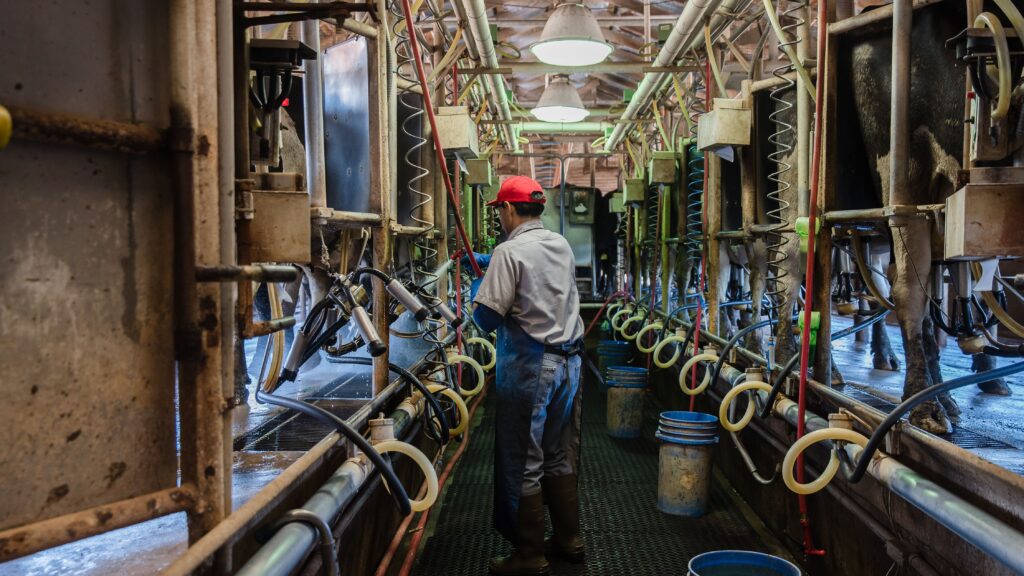WASHINGTON — The Centers for Disease Control and Prevention recommended this week that dairy and poultry farms with infected animals supply protective gear to workers in a bid to stave off human transmission of the H5N1 virus. The challenge now is making it happen.
The CDC has no legal authority to order those protective measures, and health officials in some of the nine states with reported outbreaks in cattle have had little luck getting farmers to take them up on offers of free personal protective equipment for their workers, even as the virus continues to spread. Six additional infected herds were reported yesterday — in Michigan, Idaho, and Colorado — bringing the total to 42.
Texas, the one state with a confirmed human case, in a worker exposed to infected cows, has sent protective gear to some farms — four, to be exact. The state’s health department began offering gloves, masks, goggles, and gowns to dairy farms at the beginning of April, shortly after the state’s first cases were identified. A handful of sites in the Texas panhandle — each with sick cows — accepted them. The state has reported 12 infected herds so far.
“We offered PPE to any interested dairy and only four took us up on the offer. The offer still stands,” Texas Department of State Health Services press officer Lara Anton told STAT in an email.
Similarly, in Idaho, the health department began offering protective gear to farms when federal officials confirmed the flu’s presence in one herd there early last month. They have had no takers. “We have not distributed any PPE thus far,” said AJ McWhorther, a spokesperson for the state health department.
In Michigan, which has now reported 10 herd infections, state officials have left PPE coordination to local governments, meaning there is no real picture of protective measures on the ground. “We are not tracking those PPE distributions from local health departments,” said a health department spokesperson.
Dairy groups say their members fear financial ruin if their cattle are found to be infected, and lawmakers, too, are increasingly concerned that H5N1 measures could chill the industry. There’s also the fact that protective gear is not ideal for hot working conditions such as milking parlors. “These workers have these fogged goggles all the time, which actually predisposes them to injuries,” said Michael Osterholm, an epidemiologist and director of the University of Minnesota’s Center for Infectious Disease Research and Policy. “N95 [masks] aren’t necessarily working well when they get wet.”
But while federal officials and infectious disease experts maintain the risk to the general public is still very low, the threat is more significant for those in contact with cows, especially because infected animals may not show outward signs of illness.
“The primary risk right now is among those who work in the actual milking processes. That is a big question: What’s happening there? We don’t know,” Osterholm said.
It’s a big question, because the CDC and local health authorities depend on cooperation of farmers to test not just cows, but workers.
Darren Turley, executive director of the Texas Association of Dairymen, characterized the human infection — a worker who developed pink eye — as a “one-off incident” involving an inexperienced temporary worker who may have gotten milk on his hand and then wiped his eye.
“After that, we began offering face shields,” said Turley. “But the main thing was to make sure that when you bring in an employee who is not used to working in areas with sick animals that they get the proper education beforehand.”
While employee education could minimize future transmission, there is no certainty about how it happened in the first place. CDC and Texas officials are still unable to say whether the farm worker contracted bird flu virus directly from a cow “because no specimens from cows or environmental samples were available … and epidemiological investigations were not able to be conducted at the farm.” They were unable to collect samples from the workers and his roommates, as well.
“It’s a combination where the local farms, as well as agricultural officials, have largely stymied efforts by public health to get into those farms to do testing of individuals who work there,” Osterholm said.
That may be starting to change. Todd Davis, acting chief of the CDC influenza division’s Virology, Surveillance and Diagnosis Branch said during a World Health Organization event this week that the CDC is working with state and local health departments to initiate serology studies testing farm workers’ blood for evidence of past bird flu infection.
Prioritizing masks and goggles for workers at farms with previously confirmed cow infections is a relatively moderate step in understanding the scale of the outbreak, said infectious disease experts.
“That’s not enough,” Shira Doron, a Tufts University epidemiologist and chief infection control officer, said of the CDC’s recommendation that PPE be used at farms with known H5N1 outbreaks. “It should be all [dairy farms],” she said. “Once [cows] are sick, they’re probably not contagious anymore within days, then they become the least concerning.”
But the barrier before health officials is who would launch a drive to broadly mask and goggle at dairy farms, let alone potentially require safety measures. State and federal health agencies do not have that authority. Multiple state health departments told STAT that their staffs have not stepped foot on farms with confirmed cases, citing “privacy and biosecurity reasons.”
The bureaucratic tethers for human health agencies were evident in CDC Deputy Director Nirav Shah’s statement Monday about the agency’s new recommendations. He asked state health officials to “work with their state agriculture department counterparts to identify farmworker organizations that can help coordinate and facilitate PPE distributions.” The recommendation ultimately leaves the agriculture industry to spearhead protective measures — or bypass them.
“In an ideal world, we would have a lot of surveillance,” said Doron. “But in the real world, we have farmers who may be operating on very narrow margins, may have been already financially struggling, and no structure in place to compensate them for doing the right thing, when the right thing might actually lead to a significant financial impact.”
Megan Molteni and Helen Branswell contributed to this report.










